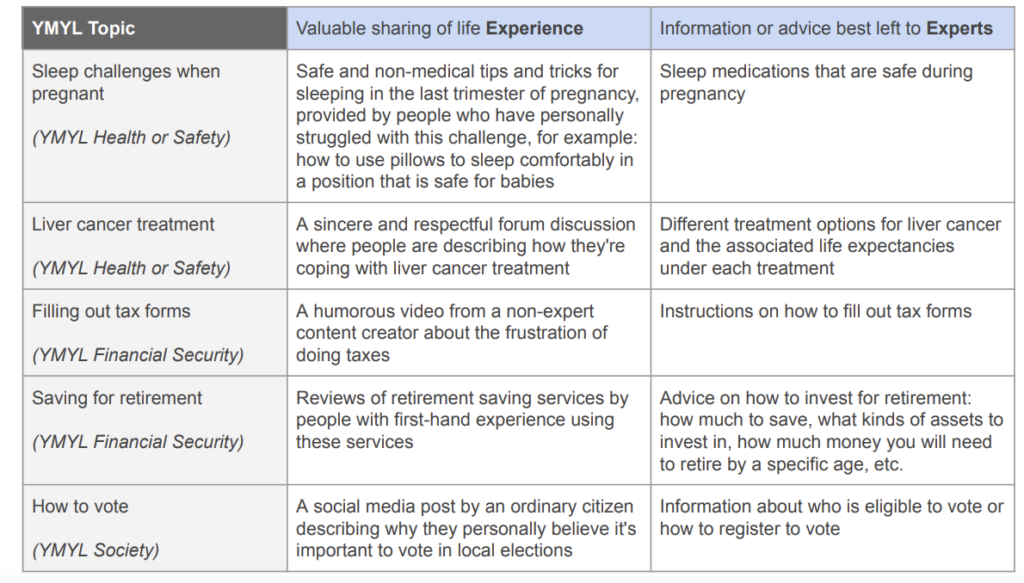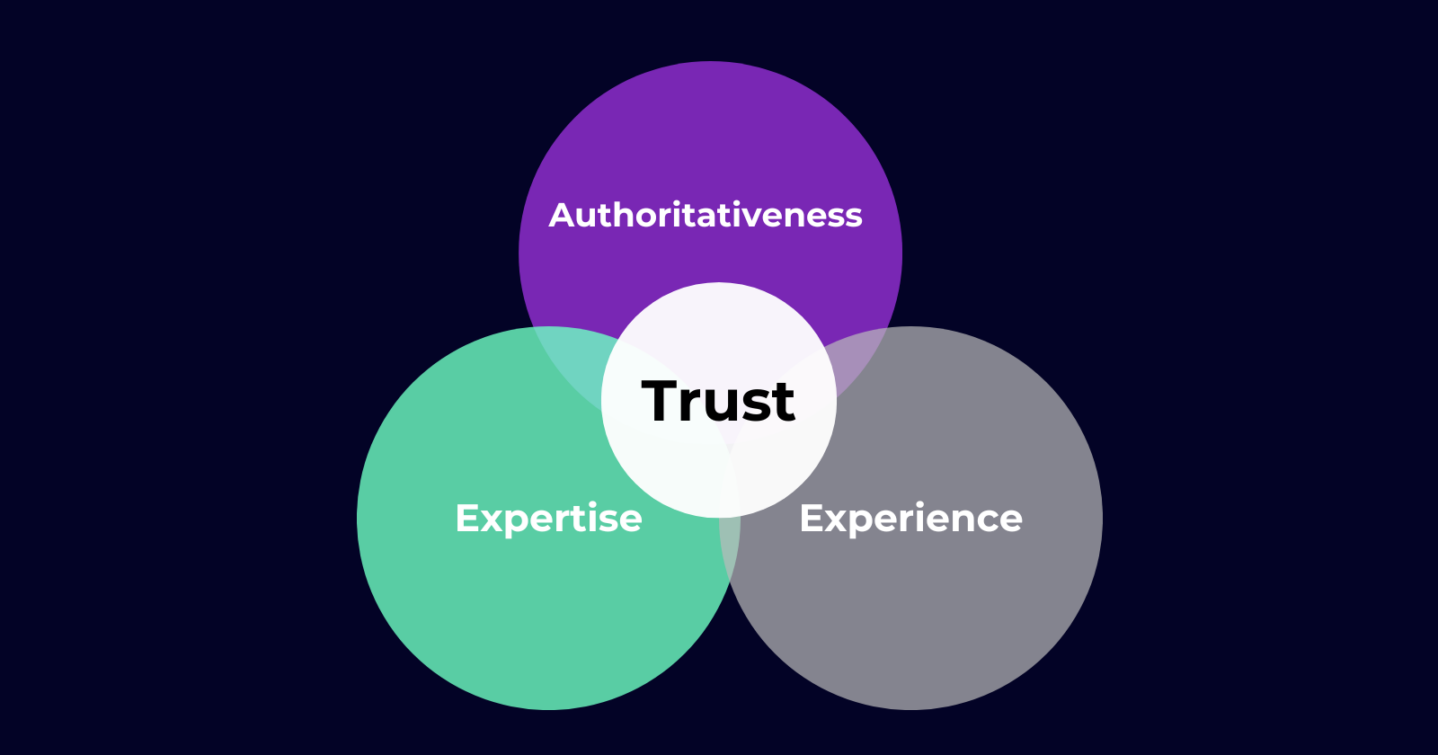In December 2022, Google updated their Quality Rater Guidelines and with it, the concept of E-A-T. Previously ‘Expertise, Authority and Trust’, Google has now extended the acronym to include ‘Experience’, in order to tackle poor-quality content published online.
In this guide, we’ll take you through the Google E-E-A-T update and how you can demonstrate experience in your content.
What is E-A-T?
E-A-T stands for Expertise (E), Authority (A) and Trust (T). These three principles are vital to SEO success, with each serving as a signal for Google to measure the value of a website. Think of them as guidelines, a way of ensuring that users can trust you and your business. The more trustworthy your site is, and the better your expertise, the more helpful your content will likely be for users.
We’ve gone into more detail about the principles of E-A-T and why it’s an essential part of your SEO strategy in this guide . In this blog, we’re going to focus on the latest Google E–E-A-T algorithm update, which saw the addition of ‘experience’ signals.
Search Quality Rater Guidelines: An overview
For more context around E-E-A-T, it’s important to understand Google’s Search Quality Rater Guidelines. These guidelines provide webmasters and content creators with an idea of what Google looks for when ranking websites in search results.
Google quality raters consist of between 10-100k human experts hired by Google to determine how effective Google’s algorithms are at solving a user’s needs. They then write feedback on the results served to them, based on the Google Quality Guidelines. Although this feedback does not directly affect rankings, they can show the impact of algorithmic changes and how this affects search. The signals of E-E-A-T can be found in detail in the guidelines.
The significance of E-E-A-T can vary depending on the industry, but is especially important for Your Money or Your Life (YMYL) websites. This acronym represents sites that can have a serious impact on a user’s life, such as medical, financial or home improvements. Given the importance of credibility when providing guidance in these areas, then it’s no surprise that E-E-A-T is a strong guideline for YMYL content. As an example, if you’re buying a house and need financial advice for your mortgage, you would go to a professional rather than someone online who you’ve never spoken to or heard of, and doesn’t appear to be an expert in this topic.
YMYL sites are now categorised into groups:
- Health or safety
- Financial security
- Society
- “Other”
But, as this is quite broad, here’s a list of examples of YMYL sites:
- Medical sites, such as the NHS, sites about workplace safety or charities.
- Financial websites, including your bank, HMRC and financial advisors (insurance, taxes, loans, etc.)
- Government websites, such as your local council.
- News sites, including the BBC, The Guardian and The Sun.
- Any other website related to important aspects of your life, such as home improvements, education and fitness.
YMYL sites are continuously highlighted throughout Google’s guidelines. They provide examples using YMYL topics, so if your site falls under this category, then you should prioritise optimising your website for E-E-A-T.
What is the Google E-E-A-T update?
As part of their latest update to the Quality Rater Guidelines, Google added ‘Experience’ to the previous E-A-T signals. This means that E-A-T is now E-E-A-T, which stands for:
- Experience – the experience the content creator has using the product or topic.
- Expertise – the content creator’s overall knowledge on the topic. This initially seems similar to ‘Experience.’ However, there are circumstances when you can be an expert on a particular topic, but there are areas you have not yet experienced.
- Authority – how reliable is the source? How often are they the go-to for the industry? For example, you’d go to the BBC for the latest news updates, or the NHS for health problems.
- Trust – Google describes this as ‘the most important member of the E-E-A-T family’. If a user doesn’t trust you or your business, they’re unlikely to buy from you or use your services. Trust signals come from reviews, case studies, About and Meet the Team pages, to name a few.
What is ‘Experience’ in E–E-A-T?
Experience represents the knowledge gained by the content creator’s first-hand experience. This type of knowledge is important for the user as it means taking advice from a genuine source.
For example, if you’re considering buying new software but want to know what the best options are, reviews would be valuable as the user can find out how good various programmes are based on users’ experiences.
Google has been using E-A-T signals for years as part of its algorithms to determine whether the content creator is providing information that users can trust. Also, the growth in AI content creation has provided businesses with a way of writing content quickly, without the depth or expertise needed to create a truly valuable piece. This is likely a reason for this update.
Google provided examples of what content written without E-E-A-T could look like:
- A restaurant review written by someone who has never been
- An article about skydiving when the creator has no experience or expertise
- Content written by someone who is not an authoritative source, such as tax form downloads on a cooking site
- A page that isn’t trustworthy enough, such as a shopping page with little customer service information.
How do you show ‘Experience’ in content?
So how do you optimise for experience in the content you’re creating? It’s not just through excellent reviews on your site. Google has provided some helpful examples of how you can best demonstrate experience versus expertise:

In a way, the E-E-A-T update demonstrates that you don’t have to be an industry leader to be an authoritative source. Depending on the query intent, experience may count for more than expertise in some cases.
It’s also interesting to note the mention of video and social media in these guidelines. As search becomes more visual and more people turn to various platforms (such as TikTok for news updates) for content, Google appears to be opening up the field in terms of what type of content E-E-A-T applies to while clearly endorsing user-generated content. The fact that experience comes from the user themselves demonstrates this further.
If you are an industry expert however, this table also shows the importance of demonstrating the other concepts of E-E-A-T – expertise, authority and trust. You can see how to optimise for these signals in our EAT for SEO success guide.
Different ways to optimise for ‘Experience’
So how exactly can you demonstrate experience in your content? As this is still a new development, you may want to trial a few ideas to see what works. Here’s a few examples that we think will help show your experience:
1. Understand the difference between expertise and experience
To ensure that you are demonstrating both your expertise and your experience, it’s critical that you understand the difference, as well as the most appropriate time to show evidence of each, as demonstrated in Google’s example above.
Remember, ‘expertise’ represents the knowledge the content creator has, whereas ‘experience’ means just that. You can have strong knowledge of a topic without experiencing some aspects for yourself, such as an illness, a sport or a DIY technique.
Consider the content you’re writing and whether expertise or experience are enough. Which would your audience prefer to see? If someone is searching for knee surgery, then you’d want to go to an authoritative source, such as a knee surgeon or the NHS. On the other hand, if you’re struggling with mental health issues and are unsure which coping method is right for you, then reading about other experiences would be more beneficial.
2. Provide evidence of your experience in your chosen subject
Your audience will want to know how you or the content creator is experienced in your chosen subject. This is where you need to be as transparent as possible. For example, if you’re reviewing an electric bike, offer a detailed account of your experience where possible. You could mention how long the battery generally lasted, the distance you were able to cover from one charge or how easily it was to store.
Also consider your knowledge of other products too, as having experience with similar products or services can act as the lens that you view your experience through. If you’re writing about a new iPhone, use your previous experience with another model as a means of comparison.
For this reason, it is worth understanding whether your product or service is comparable to anything else that you have experience with. What can this new product or service offer that others can’t?
Where you can, include relevant awards and case studies within your content, either embedded in the content itself or internally linked. These credentials are proof of your experience and tie in to the other principles of E-E-A-T.
3. Include advice from industry experts
If you don’t feel confident enough in your own experience, you can turn to other industry leaders to back you up. Reach out to other content creators or influencers and ask if they can provide their own tips for your content.
This is a journalistic approach that will make your blog look more professional and can help fill in any gaps that you may have. As the experts you include can add weight to your own comments, placing you in a stronger spotlight.
It’s important to note that, if you create content this way, every contributor’s credentials must be made clear – and yes, this does include yours. Google has emphasised the importance of authorship in their updated Search Raters Guidelines, including the owner of the site. Include author bios for yourself and other contributors so it’s evident to readers that you all have enough experience and expertise to give advice.
Showcasing E-E-A-T in your content
Here at Loom, we know how to make your business stand out. Optimising for E-E-A-T means showcasing you and your brand, and our expert content and SEO team can help you do that with both users and search engines in mind. To start putting together your content strategy, speak to our expert team by calling 0117 923 2021 or sending an email to: [email protected]





